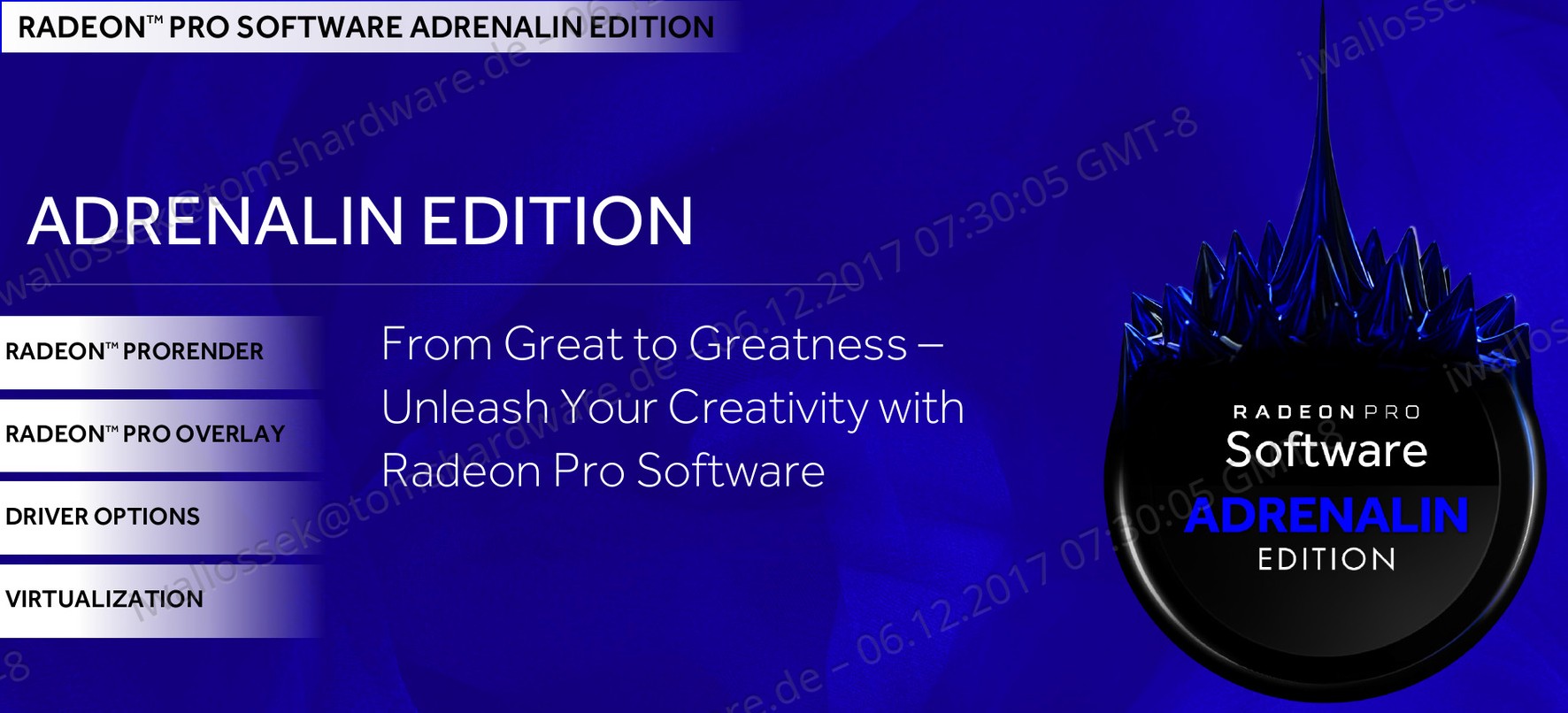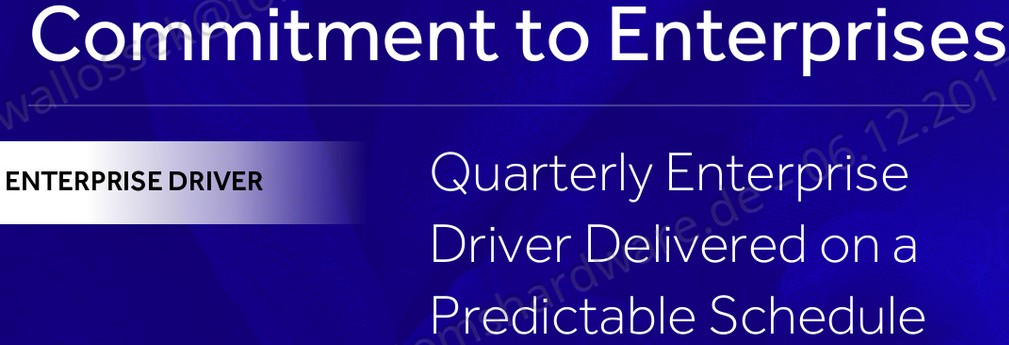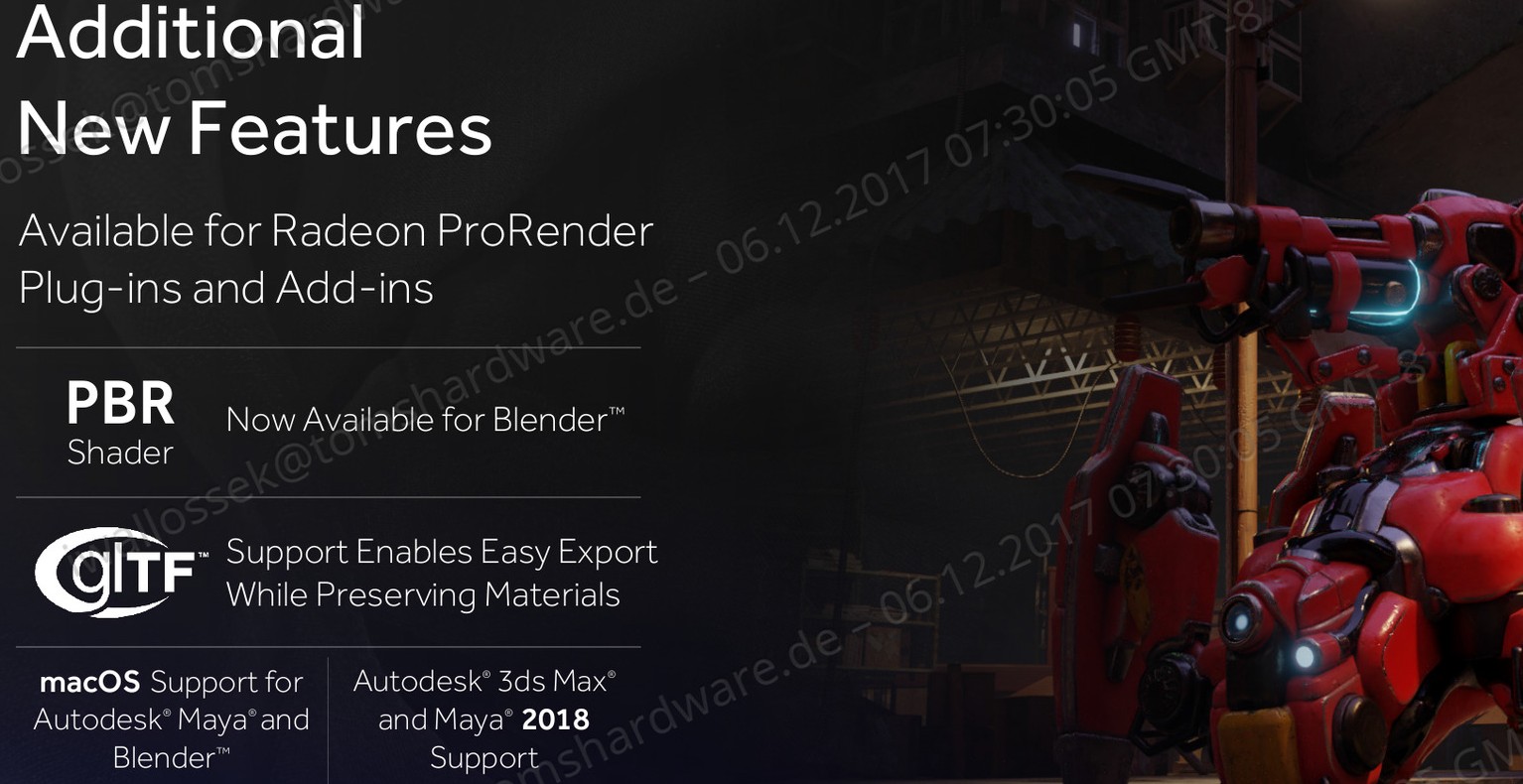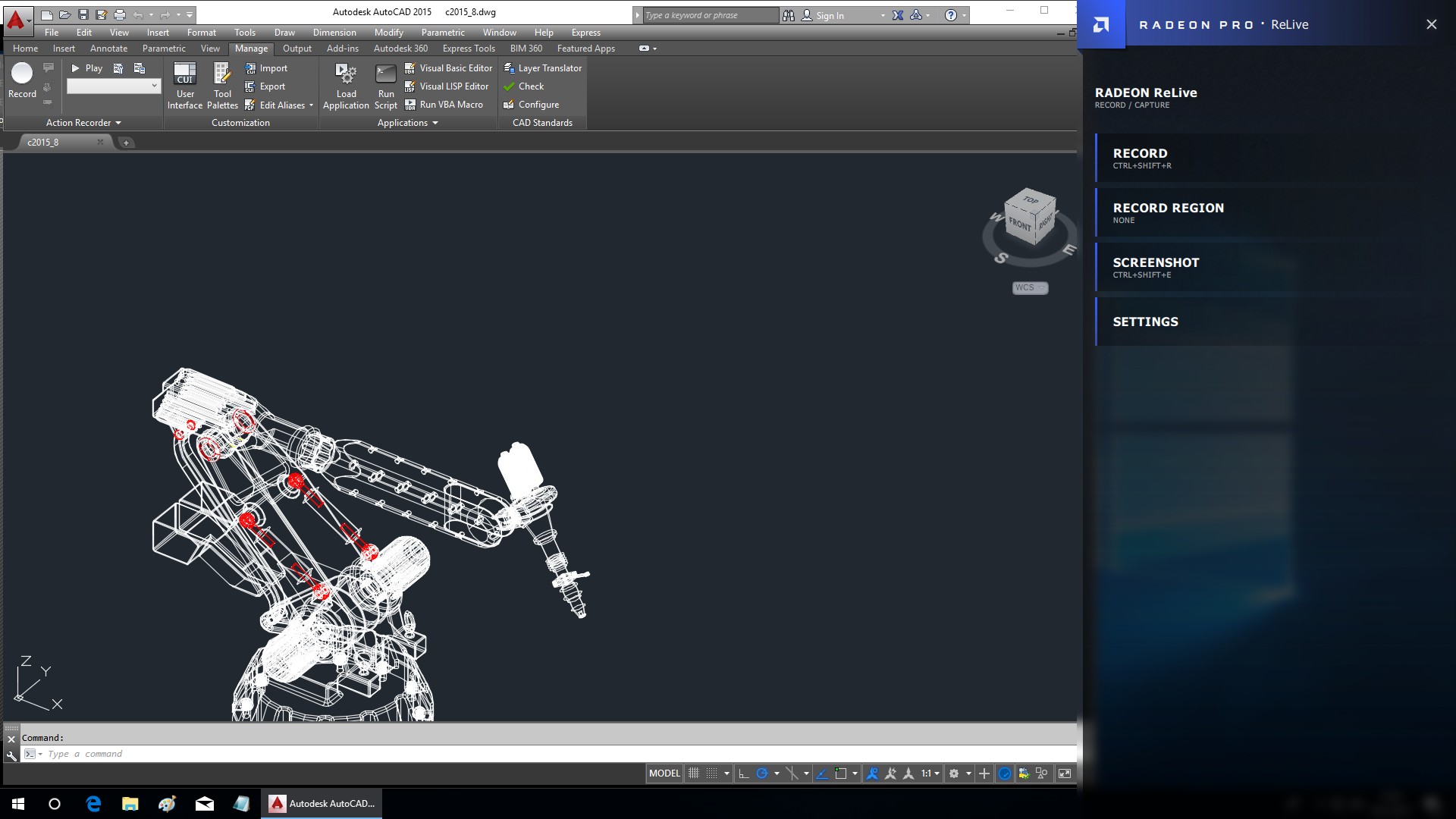Radeon Pro Goes Enterprise: Adrenalin Edition For Workstations
In addition to AMD's desktop-oriented Radeon Software Adrenalin Edition, it's also time for the company to introduce its Radeon Pro Software Adrenalin Edition.
Although we initially had trouble getting AMD's press build installed, a second version of the driver made available to reviewers did behave as expected. It included an extra bit of text in the file name: CWG-Enabled-Gaming. Those first three letters stand for CreatorWhoGames, so we weren't surprised to discover that game profiles were automatically available to our Radeon Pro WX 7100, even though it's a pure workstation card. Makes us wonder what advantages the Radeon Pro WX 9100 will offer over Radeon Vega Frontier Edition, particularly when the former costs $600 more than the latter.
The Update Cycle
Back to the driver itself. Enterprise-class means that you count on this software in terms of planning, stability, updates to support a changing operating environment, and optimizations for the professional applications that matter. Certified or not, confidence in the hardware and its underlying infrastructure plays a role in your purchasing decision. AMD is on a quarterly update schedule with fixed dates for publication so that roll-outs can be planned in advance. In fact, we already know the drivers go live on the second Wednesday of the second month each quarter.
Radeon ProRender
ProRender isn't new, but it's one of those features that AMD continues to develop. With its Radeon Pro Software Adrenalin Edition update, this physically-based rendering engine gains support for interactive viewport denoising. Known information is mixed with 3D real-time content to generate a clear render preview. The advantage is obvious: you don't have to wait forever for the render to finish, yet can still identify possible mistakes.
The Game Engine Importer is also improved, making it possible to pull geometry and materials into real-time engines for viewing in VR. The boundaries between building a project, visualizing it, and even interacting with it in virtual reality continue to blur. This is by no means a gimmick. It utilizes the mature functionality and high performance of platforms like the Unreal Engine not for entertainment, but productivity. Suddenly, AMD's idea to enable workstation cards with gaming optimizations makes a lot more sense. After all, not everything coming out of game engines is diversion these days.
Physically-based rendering facilitates the use of realistic materials and lighting models, yielding a better-looking real-time preview than you'd get from static and artificial Phong shading. This PBR shader is now available for Blender, joining 3ds Max and Maya 2018 on the PC. If you're on macOS, you get support via Maya and Blender. In addition, you have to mention Cinema4D, where AMD's Radeon ProRender feature plays an interesting role, enabling content creation with decent acceleration.
ReLive And Overlay
AMD's ReLive feature also makes its way into the workstation space, delivering functionality that was previously only available through third-party software. Similar to what ReLive does on the desktop for games, you're able to save on-screen content as an image or video, with or without sound, then store, edit, or share that content with others. The new overlay, which makes it possible to fade-in your own camera using chroma keying, brings video work into a familiar interface. A lot of folks are going to find this workflow more comfortable than learning an entirely new piece of software.
Get Tom's Hardware's best news and in-depth reviews, straight to your inbox.
Virtualization
AMD continues its push in the virtualization space with MxGPU technology, first discussed back in 2016 and enabled with a previous generation of GCN-based hardware. For this release, the company is talking about its open-source KVM host OS driver, available on GitHub. The argument in favor of a solution like this is that it can save costs and provide more transparency than proprietary solutions. We only have to hope its performance can keep up with those competing solutions.
Performance: From 2016 To Today
In an effort to track AMD's performance over time, we pulled out its Radeon Pro WX 7100 and installed the Radeon Pro and AMD FirePro Software Enterprise 16.Q4 driver. We determined the card's performance mid-year with Radeon Pro Software Enterprise 17.Q3 (from July '17), and then tested with the new driver, Radeon Pro Adrenalin 17.5.
We also tested the Vega-based Frontier Edition and realized that nothing really changed between its launch this summer and today. Obviously, that older 16.Q4 driver doesn't support any of the Vega cards. Actual improvements must have happened in the first half of 2017.
The benchmarks show that AMD was able to boost some of its SPECviewperf scores, though other changes between 2016 and 2017 are more modest. Fluctuations of about one percent are normal, and thus fall below our measurement tolerances.
Using the full version of professional applications yields more interesting results. After all, freely-accessible metrics like SPECviewperf receive a disproportionate amount of optimization time. Gains achieved in a test everyone can run are more likely to be reproduced around the Web, which makes for great marketing. And that's why we make it a point to run a more diverse benchmark suite.
Conclusion
Aside from the driver's initial failure to install, we come to the same conclusion here as our U.S. team covering AMD's desktop-oriented Radeon Software Adrenalin Edition release: this update furthers AMD's cause against a relentless competitor. Improved features, new functionality, and a well-defined roadmap make it clear that AMD has its eye on the prize, and understands what an enterprise customer needs from a professional product. Keep up the momentum, AMD. We certainly approve of your work.
MORE: Best Graphics Cards
MORE: Desktop GPU Performance Hierarchy Table
MORE: All Graphics Content

Igor Wallossek wrote a wide variety of hardware articles for Tom's Hardware, with a strong focus on technical analysis and in-depth reviews. His contributions have spanned a broad spectrum of PC components, including GPUs, CPUs, workstations, and PC builds. His insightful articles provide readers with detailed knowledge to make informed decisions in the ever-evolving tech landscape
-
AgentLozen AMD has pleasantly surprised me in 2017 (except for Vega). I hope they keep doing this through 2018.Reply -
FormatC I'm also surpised. I'm using a Vega FE, a WX 7100, WX 5100 and the Quadro line-up from P6000 to P2000. In any cases the Radeon Pro cards are not worse but a lot cheaper. But it depends at the used software. In some fields I can't use AMD hardware ;)Reply -
JonDol Reply20475335 said:AMD has pleasantly surprised me in 2017 (except for Vega). I hope they keep doing this through 2018.
I'm guessing you are a pure gamer and as almost all the other gamers out there you utterly fail to understand anything else than gaming performance. So you may be right in that respect but as you simply mentioned Vega only I have remember you that Vega is not only gaming:
- there are plenty of tests on the Internet that shows it has a better efficiency for cryptocurrencies mining than Nvidia equivalent cards for the money
- and there is the amazing Vega FE for pro work that has a driver for gaming which has reasonable performance and this is something Nvidia does not have yet: you'll have to choose between either gaming either pro work so you can't have an all in one solution like the Vega FE.
Cheers -
AgentLozen ReplyJonDol said:I'm guessing you are a pure gamer and as almost all the other gamers out there you utterly fail to understand anything else than gaming performance.
You hit the nail on the head my dude. Gaming and thermal performance are the metrics I'm most concerned about when I look at a video card. It's overall gaming efficiency is much lower than similarly priced Nvidia cards. This was disappointing because it came out nearly a year after the Nvidia's equivalent hardware was already on the market.
Regarding crypto currency mining, the Tomshardware review of Vega 64 shows that AMD cards have an advantage over Nvidia cards. However, Vega 64 was only incrementally faster than the Radeon R9 390X. There doesn't seem to be proportional performance increase between generations. When you consider the differences in fabrication techniques and advances in technology, this is also disappointing.
There is some merit to your post and I usually just let this stuff go, but you lead your post with "... you utterly fail to understand anything else than gaming performance..." That makes me seem like some sort of neanderthal. It really hurt my feelings. =(
Let's both agree to not begin our reply posts with military grade insults in the future. Thank you =)
-
derekullo "Ethereum Mining"Reply
The Vega 64 does about 40 Megahashes a second using 230 watts for an effective 0.17 hashes per watt.
The Geforce 1080 does about 35 Megahashes a second using 140 watts for an effective 0.25 hashes per watt.
https://whattomine.com/
Besides heating your house better the AMD card has no advantage in mining.
Hashes per watt is king unless you get your power free.
At which point ... MINE BABY MINE.
The whattomine site assumes you configured your cards correctly, overclock / TDP limit.
Tom's actually reported the hash rate of the Vega 64 as lower than the Geforce 1080Ti
http://www.tomshardware.com/reviews/amd-radeon-rx-vega-64,5173-16.html
Which may have been when AMD was having that dag driver issue. -
rich1051414 That's with stock bios. You can do 40 mHash/s on a power draw of 192 watts on Vega 64 if you undervolt it. If you are lucky, you can push that even further. Right now, Vega offers the most hashrate efficiency. You cannot look at the extremes and base your opinions on that. That is not realistic.Reply -
AgentLozen Replyderekullo said:The Geforce 1080 does about 35 Megahashes a second using 140 watts for an effective 0.25 hashes per watt.
I thought the GeForce 1080's GDDR5X memory tripped up Ethereum mining. I've read that the 1080 Ti gets around this problem with it's wider bus width. -
JonDol Reply20475624 said:
There is some merit to your post and I usually just let this stuff go, but you lead your post with "... you utterly fail to understand anything else than gaming performance..." That makes me seem like some sort of neanderthal. It really hurt my feelings. =(
Let's both agree to not begin our reply posts with military grade insults in the future. Thank you =)
My apologies if my ankward phrasing sounded like a personal offense, it was not at all intended. Thats why I wasn't absolute in my affirmation and my sentence started with "_almost_ all gamers".
Cheers








